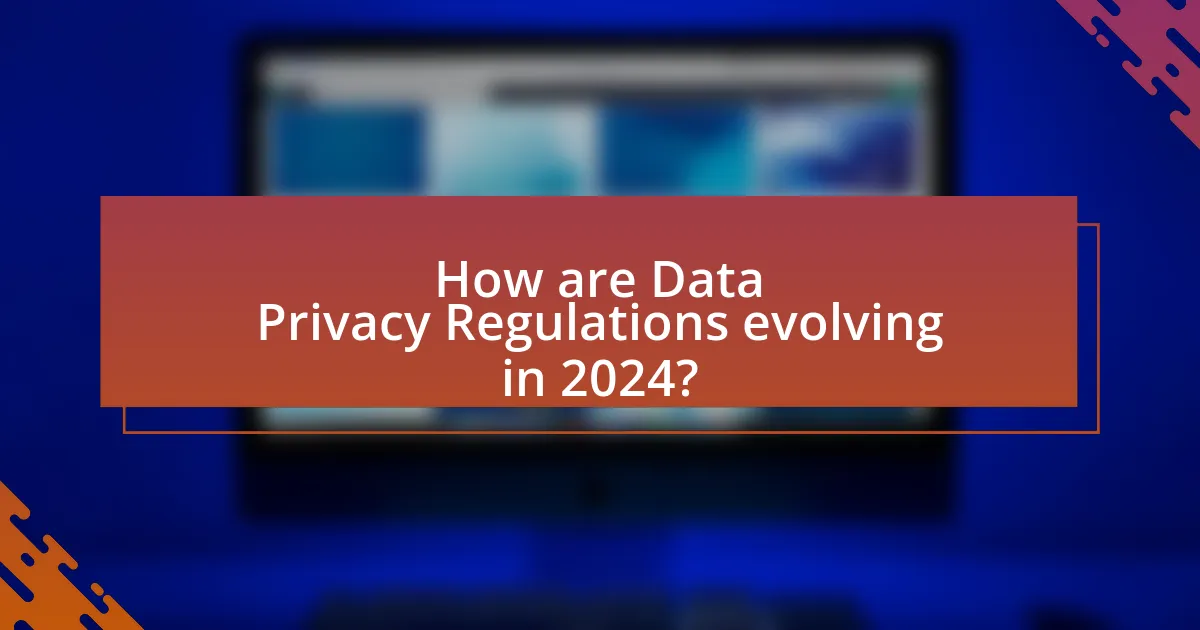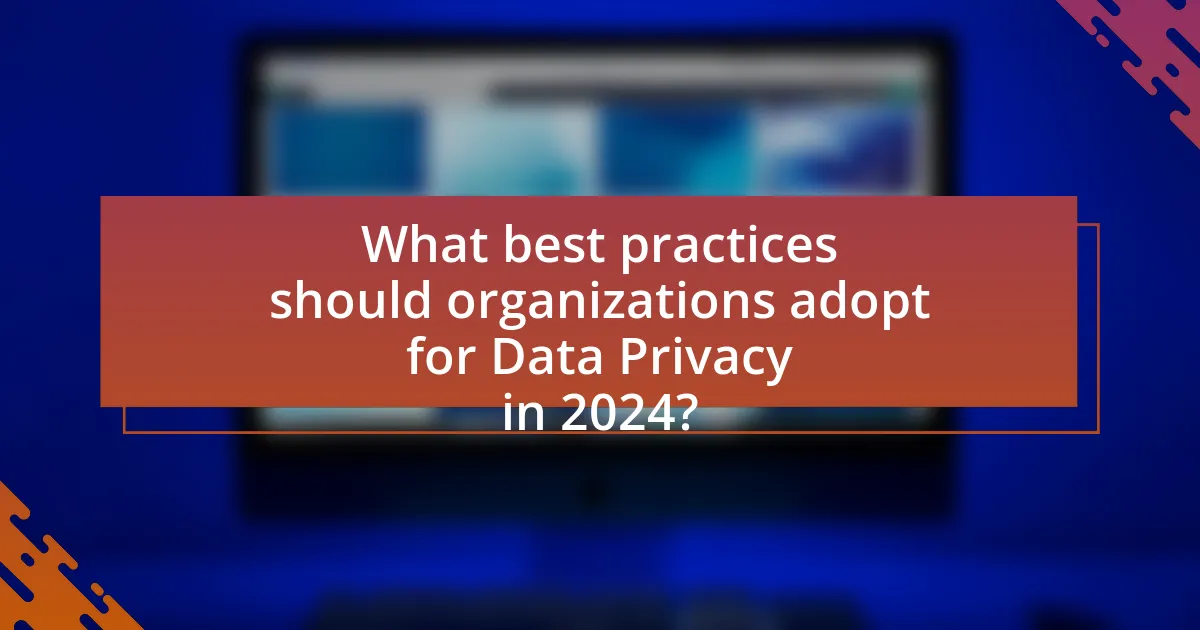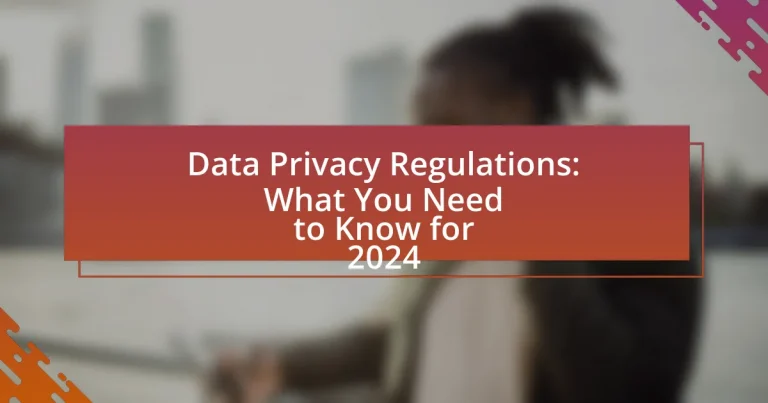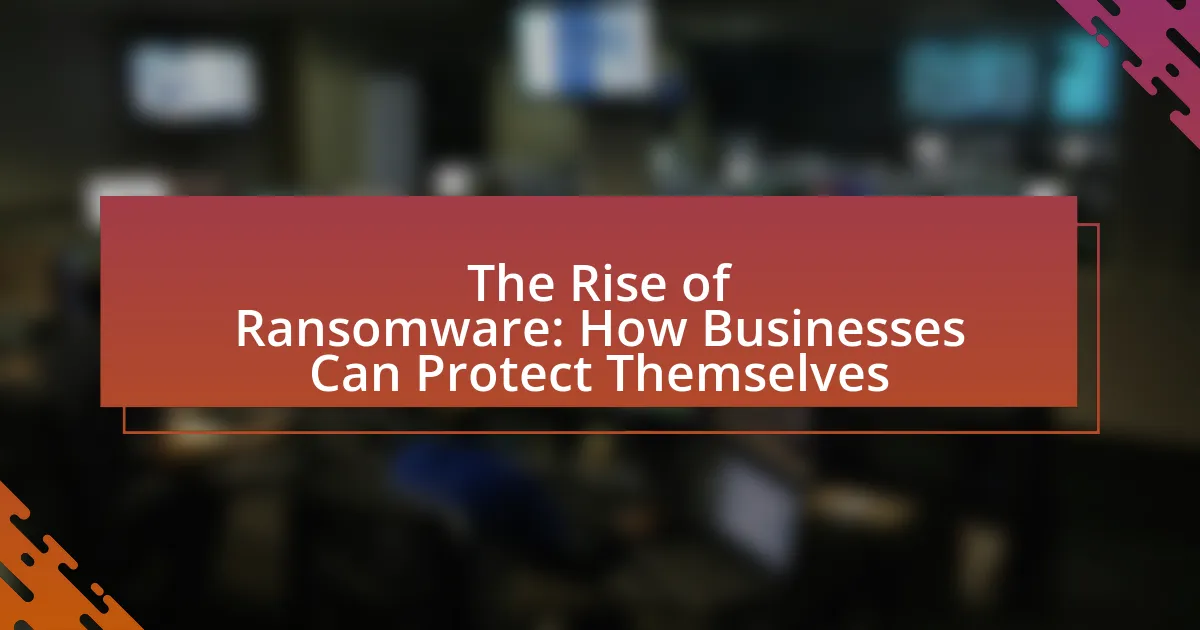Data privacy regulations are legal frameworks designed to govern the collection, storage, and use of personal data by organizations, with the primary goal of protecting individuals’ privacy rights. In 2024, these regulations, including the General Data Protection Regulation (GDPR) and the California Consumer Privacy Act (CCPA), are crucial for safeguarding personal information against misuse and ensuring compliance with technological advancements. The article outlines the importance of these regulations, the rights they confer to individuals, the consequences of non-compliance, and the key components that define them. Additionally, it discusses emerging trends, challenges organizations face in compliance, and best practices for maintaining data privacy, providing a comprehensive overview of the evolving landscape of data privacy regulations.

What are Data Privacy Regulations?
Data privacy regulations are legal frameworks that govern the collection, storage, and use of personal data by organizations. These regulations aim to protect individuals’ privacy rights and ensure that their personal information is handled responsibly. For example, the General Data Protection Regulation (GDPR) in the European Union mandates strict guidelines for data processing and grants individuals rights such as access to their data and the right to be forgotten. Compliance with these regulations is essential for organizations to avoid significant penalties and maintain consumer trust.
Why are Data Privacy Regulations important in 2024?
Data privacy regulations are important in 2024 because they protect individuals’ personal information from misuse and ensure compliance with evolving technological standards. As data breaches and cyber threats increase, regulations like the General Data Protection Regulation (GDPR) and the California Consumer Privacy Act (CCPA) provide frameworks that hold organizations accountable for data handling practices. In 2023 alone, data breaches exposed over 400 million records, highlighting the need for stringent regulations to safeguard consumer trust and privacy.
How do Data Privacy Regulations protect individuals’ rights?
Data privacy regulations protect individuals’ rights by establishing legal frameworks that govern the collection, use, and storage of personal data. These regulations, such as the General Data Protection Regulation (GDPR) in Europe, grant individuals rights including the right to access their data, the right to rectify inaccuracies, and the right to erase personal information. For instance, GDPR mandates that organizations must obtain explicit consent from individuals before processing their data, ensuring that individuals have control over their personal information. Additionally, these regulations impose penalties on organizations that fail to comply, thereby incentivizing the protection of individual rights and enhancing accountability in data handling practices.
What are the potential consequences of non-compliance?
The potential consequences of non-compliance with data privacy regulations include significant financial penalties, legal repercussions, and reputational damage. For instance, organizations may face fines that can reach up to 4% of their annual global revenue under regulations like the General Data Protection Regulation (GDPR). Additionally, non-compliance can lead to lawsuits from affected individuals or regulatory bodies, further exacerbating financial losses. Reputational damage can result in loss of customer trust, which is critical in maintaining a competitive edge in the market. According to a study by IBM, the average cost of a data breach is approximately $4.24 million, highlighting the financial risks associated with non-compliance.
What are the key components of Data Privacy Regulations?
The key components of Data Privacy Regulations include data protection principles, individual rights, compliance requirements, enforcement mechanisms, and penalties for non-compliance. Data protection principles, such as data minimization and purpose limitation, guide how organizations should handle personal data. Individual rights, including the right to access, rectify, and erase personal data, empower users to control their information. Compliance requirements mandate organizations to implement appropriate security measures and conduct impact assessments. Enforcement mechanisms, often established by regulatory bodies, ensure adherence to regulations, while penalties for non-compliance can include fines and legal actions, as seen in the General Data Protection Regulation (GDPR), which imposes fines up to 4% of annual global turnover.
What types of data are covered under these regulations?
Data privacy regulations cover personal data, which includes any information that relates to an identified or identifiable individual. This encompasses various types of data such as names, identification numbers, location data, online identifiers, and other factors specific to the physical, physiological, genetic, mental, economic, cultural, or social identity of a person. Regulations like the General Data Protection Regulation (GDPR) specifically define personal data to ensure comprehensive protection of individuals’ privacy rights.
How do these regulations define personal data?
Regulations define personal data as any information that relates to an identified or identifiable individual. This includes names, identification numbers, location data, and online identifiers, among other attributes that can directly or indirectly identify a person. For instance, the General Data Protection Regulation (GDPR) explicitly states that personal data encompasses any data that can be used to identify an individual, thereby establishing a broad scope for what constitutes personal data in the context of data privacy.
What are the major Data Privacy Regulations to be aware of in 2024?
The major data privacy regulations to be aware of in 2024 include the General Data Protection Regulation (GDPR) in the European Union, the California Consumer Privacy Act (CCPA) in the United States, and the Health Insurance Portability and Accountability Act (HIPAA) for healthcare data. GDPR mandates strict data protection and privacy measures for individuals within the EU, while CCPA provides California residents with rights regarding their personal information, including the right to know, delete, and opt-out of the sale of their data. HIPAA sets standards for the protection of health information, ensuring patient privacy and security. These regulations reflect a global trend towards enhanced data privacy and consumer rights, necessitating compliance for organizations handling personal data.
What is the General Data Protection Regulation (GDPR)?
The General Data Protection Regulation (GDPR) is a comprehensive data protection law enacted by the European Union in May 2018. It establishes guidelines for the collection and processing of personal information of individuals within the EU and the European Economic Area. The GDPR aims to enhance individuals’ control over their personal data and simplify the regulatory environment for international business by unifying data protection regulations across Europe. It imposes strict requirements on organizations regarding data handling, consent, and the rights of individuals, including the right to access, rectify, and erase personal data.
What is the California Consumer Privacy Act (CCPA)?
The California Consumer Privacy Act (CCPA) is a state law that enhances privacy rights and consumer protection for residents of California. Enacted in 2018, the CCPA grants California residents the right to know what personal data is being collected about them, the purpose of its collection, and the ability to access, delete, and opt-out of the sale of their personal information. The law applies to businesses that meet certain criteria, such as having annual gross revenues over $25 million or collecting personal data from 50,000 or more consumers. The CCPA represents a significant step in data privacy legislation, aiming to give consumers more control over their personal information.

How are Data Privacy Regulations evolving in 2024?
Data privacy regulations are evolving in 2024 through the implementation of stricter compliance requirements and enhanced consumer rights. Governments worldwide are focusing on frameworks that emphasize transparency, data minimization, and user consent, reflecting a growing demand for accountability in data handling practices. For instance, the European Union’s General Data Protection Regulation (GDPR) continues to influence global standards, prompting countries like Brazil and India to adopt similar comprehensive laws. Additionally, the rise of artificial intelligence and data analytics is driving regulators to address new challenges, leading to proposed regulations that specifically target AI’s impact on privacy. These developments indicate a trend towards more robust protections for individuals’ personal data, aligning with public expectations for privacy in an increasingly digital world.
What recent changes have been made to Data Privacy Regulations?
Recent changes to Data Privacy Regulations include the implementation of the California Privacy Rights Act (CPRA), which took effect on January 1, 2023, enhancing consumer rights regarding personal data. The CPRA establishes new requirements for businesses, such as the obligation to disclose data collection practices and the right for consumers to opt-out of data sharing. Additionally, the European Union’s General Data Protection Regulation (GDPR) has seen updates, including stricter enforcement measures and increased fines for non-compliance, reflecting a global trend towards more robust data protection frameworks. These changes aim to provide individuals with greater control over their personal information and hold organizations accountable for data privacy practices.
How do these changes impact businesses and consumers?
Data privacy regulations significantly impact businesses and consumers by imposing stricter compliance requirements and enhancing consumer protection. Businesses must invest in data management systems and processes to ensure compliance, which can increase operational costs. For example, the General Data Protection Regulation (GDPR) has led to an estimated cost of €7.8 billion for companies in the EU to implement necessary changes. Consumers benefit from these regulations through increased transparency and control over their personal data, as seen in surveys where 80% of consumers express a desire for more control over their information. Thus, while businesses face higher costs and operational challenges, consumers gain improved privacy rights and protections.
What trends are emerging in data privacy legislation?
Emerging trends in data privacy legislation include the increasing adoption of comprehensive data protection laws, a focus on consumer rights, and the rise of regulatory frameworks that emphasize accountability and transparency. For instance, the implementation of the General Data Protection Regulation (GDPR) in Europe has influenced similar laws globally, such as the California Consumer Privacy Act (CCPA) in the United States, which grants consumers greater control over their personal data. Additionally, there is a growing emphasis on data minimization and purpose limitation, requiring organizations to collect only the data necessary for specific purposes. This trend is supported by the evolving landscape of privacy regulations, which increasingly hold companies accountable for data breaches and misuse, as seen in recent enforcement actions against major corporations for non-compliance.
What challenges do organizations face in complying with Data Privacy Regulations?
Organizations face several challenges in complying with Data Privacy Regulations, including the complexity of regulations, resource constraints, and the need for ongoing employee training. The complexity arises from the varying requirements across different jurisdictions, such as the General Data Protection Regulation (GDPR) in Europe and the California Consumer Privacy Act (CCPA) in the United States, which can create confusion and increase compliance costs. Resource constraints, particularly for small and medium-sized enterprises, limit the ability to implement necessary technologies and processes for compliance. Additionally, organizations must invest in continuous employee training to ensure that staff understand and adhere to privacy policies, which can be time-consuming and costly. These challenges collectively hinder effective compliance and increase the risk of non-compliance penalties.
How can organizations assess their current compliance status?
Organizations can assess their current compliance status by conducting a comprehensive compliance audit that evaluates adherence to relevant data privacy regulations. This audit should include a review of policies, procedures, and practices against regulatory requirements such as the General Data Protection Regulation (GDPR) or the California Consumer Privacy Act (CCPA).
To ensure accuracy, organizations can utilize compliance checklists and frameworks, such as the NIST Cybersecurity Framework, which provides guidelines for assessing compliance levels. Additionally, engaging third-party auditors can offer an objective evaluation of compliance status, identifying gaps and areas for improvement. Regular assessments, including risk assessments and employee training evaluations, further reinforce compliance efforts and ensure ongoing adherence to evolving regulations.
What are common pitfalls in data privacy compliance?
Common pitfalls in data privacy compliance include inadequate data mapping, lack of employee training, and failure to implement proper security measures. Inadequate data mapping can lead to organizations not fully understanding what personal data they hold, making it difficult to comply with regulations like GDPR, which requires transparency about data usage. Lack of employee training results in unintentional breaches, as employees may not be aware of compliance requirements or best practices for data handling. Additionally, failure to implement proper security measures can expose organizations to data breaches, which not only violate compliance but also damage reputation and incur financial penalties. According to a 2022 report by the Ponemon Institute, the average cost of a data breach is $4.35 million, underscoring the importance of addressing these pitfalls to ensure compliance and protect sensitive information.

What best practices should organizations adopt for Data Privacy in 2024?
Organizations should adopt a comprehensive data privacy framework that includes data minimization, regular audits, and employee training in 2024. Data minimization ensures that only necessary personal data is collected and retained, reducing exposure to breaches. Regular audits help identify vulnerabilities and ensure compliance with evolving regulations, such as the General Data Protection Regulation (GDPR) and the California Consumer Privacy Act (CCPA). Employee training fosters a culture of privacy awareness, equipping staff with the knowledge to handle data responsibly. According to a 2023 report by the International Association of Privacy Professionals, organizations that implement these practices significantly reduce the risk of data breaches and enhance consumer trust.
How can organizations ensure compliance with Data Privacy Regulations?
Organizations can ensure compliance with Data Privacy Regulations by implementing comprehensive data protection policies and conducting regular audits. These policies should include clear guidelines on data collection, storage, processing, and sharing, aligned with regulations such as the General Data Protection Regulation (GDPR) and the California Consumer Privacy Act (CCPA). Regular audits help identify compliance gaps and ensure that data handling practices meet legal requirements. According to a 2021 report by the International Association of Privacy Professionals (IAPP), organizations that actively engage in compliance training and risk assessments are 30% more likely to avoid data breaches and regulatory fines.
What role does employee training play in data privacy compliance?
Employee training is essential for data privacy compliance as it equips staff with the knowledge and skills necessary to handle sensitive information responsibly. Effective training programs ensure that employees understand data protection laws, organizational policies, and best practices for safeguarding personal data. According to a study by the Ponemon Institute, organizations with comprehensive data privacy training programs experience 50% fewer data breaches compared to those without such training. This highlights the critical role that informed employees play in mitigating risks associated with data privacy violations.
How can technology assist in maintaining data privacy?
Technology assists in maintaining data privacy through encryption, access controls, and data anonymization. Encryption secures data by converting it into a coded format, making it unreadable without the appropriate decryption key; for instance, AES (Advanced Encryption Standard) is widely used to protect sensitive information. Access controls limit who can view or manipulate data, ensuring that only authorized users have access; implementing role-based access control (RBAC) can significantly reduce the risk of unauthorized access. Data anonymization techniques, such as differential privacy, help protect individual identities within datasets, allowing organizations to analyze data without compromising personal information. These technological measures collectively enhance data privacy by safeguarding sensitive information against unauthorized access and breaches.
What resources are available for understanding Data Privacy Regulations?
Resources available for understanding Data Privacy Regulations include government websites, legal databases, and educational platforms. Government websites such as the European Commission’s GDPR page provide official guidelines and updates on regulations like the General Data Protection Regulation. Legal databases, such as Westlaw and LexisNexis, offer comprehensive legal texts and case law related to data privacy. Additionally, educational platforms like Coursera and edX offer courses on data privacy laws, often created by universities or legal experts, which can enhance understanding of the subject. These resources collectively provide a solid foundation for comprehending the complexities of data privacy regulations.
Where can organizations find guidance on compliance strategies?
Organizations can find guidance on compliance strategies through government websites, industry associations, and legal firms specializing in data privacy. For instance, the Federal Trade Commission (FTC) provides resources and guidelines on compliance with data privacy regulations. Additionally, organizations can refer to the International Association of Privacy Professionals (IAPP), which offers training and certification programs focused on compliance strategies. Legal firms such as Baker McKenzie and Hogan Lovells also publish insights and white papers that detail compliance best practices and regulatory updates, ensuring organizations stay informed about evolving data privacy laws.
What tools can help in monitoring data privacy practices?
Tools that can help in monitoring data privacy practices include data loss prevention (DLP) software, privacy management platforms, and compliance management tools. DLP software, such as Symantec DLP and McAfee Total Protection for Data Loss Prevention, enables organizations to identify and protect sensitive data across various environments. Privacy management platforms like OneTrust and TrustArc assist in automating compliance with regulations such as GDPR and CCPA, providing features for risk assessments and data mapping. Compliance management tools, including LogicGate and RSA Archer, help organizations track and manage their compliance obligations effectively. These tools are essential for ensuring adherence to data privacy regulations and mitigating risks associated with data breaches.
What practical steps can individuals take to protect their data privacy?
Individuals can protect their data privacy by implementing strong passwords and enabling two-factor authentication on their accounts. Strong passwords, which include a mix of letters, numbers, and symbols, significantly reduce the risk of unauthorized access; according to a study by the National Institute of Standards and Technology, using complex passwords can decrease the likelihood of a successful cyber attack. Additionally, individuals should regularly update their software and applications to patch security vulnerabilities, as outdated software is a common target for cybercriminals. Utilizing privacy settings on social media platforms and being cautious about sharing personal information online further enhances data privacy. Lastly, individuals should consider using a virtual private network (VPN) to encrypt their internet connection, which protects their data from potential interception.




